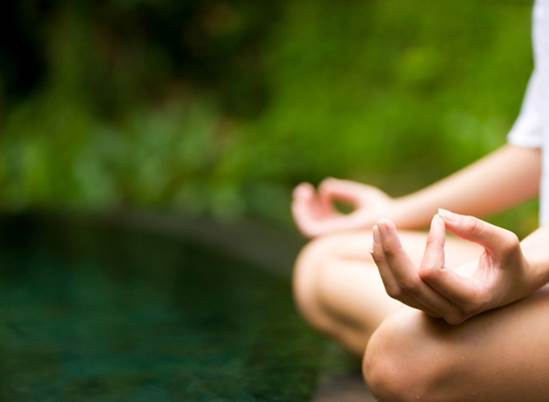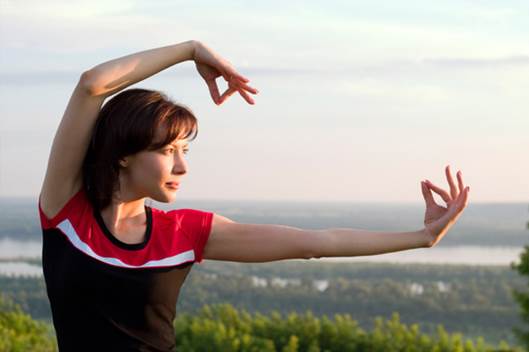The trend for holistic body practices
continues to grow but how do you know which one is best for you?
Yoga
Yoga is a physical, spiritual and mental
practice that originates in India. There are many different styles to choose
from to suit all levels of experience.
Class style:
A typical class lasts 60 to 90 minutes and may start with a relaxation
exercise, move on to physical postures and end with a meditation. Physical
poses are done mostly on mats and may sometimes require aids such as blocks,
straps and bolsters.

Yoga
is a physical, spiritual and mental practice that originates in India
It’s perfect for you... if you're looking for an exercise class with a spiritual element.
Holding poses isn’t for everyone, but for those who enjoy gently pushing their
body's limits to the tune of their own deep breathing, yoga can be especially
enjoyable. And while it's normally slow-paced, there are dynamic yoga practices
for those who prefer to speed things up a little.
After a class you can expect to feel light
and balanced, with a peaceful mind, making it the perfect class for anyone who
sits at a desk all day. It's also the perfect antidote to a busy gym routine
and helps you perform at your best in any other exercise.
Body benefits: Dominique Santana Salerno, principle of the Australian Yoga
Academy, says yoga benefits your digestive, nervous, endocrine, cardiovascular
and muscular- skeletal systems. Plus, regular practice improves strength,
flexibility, balance and cardiovascular endurance. Blood sugar levels are
steadier, cholesterol levels lower and back and joint pain can be greatly
alleviated.
Wellbeing boost: "Yoga means 'union', as it seeks
to integrate the whole person by bringing into balance the body and stabilizing
the mind,” says Salerno.
One of the most notable benefits of yoga is
its stress-reducing effect. By gently relaxing the mind and body, yoga has the
power to improve your overall health.
Tai Chi
An ancient Chinese art form practiced since
the 16th century, tai chi is one of the gentlest - but not necessarily the
easiest - martial arts to have inspired the West. The yang style is the most
common - it's highly regarded in China and responsible for the growing
popularity of tai chi in Australia.
Class style:
Each yang routine takes between five and 30 minutes. "The legs act as a
base, the waist as an axis and the hands, eyes, upper body and limbs as a whole
throughout the exercise,' says Master Han Jin Song, chief instructor of Tai Chi
Australia. "The body is in constant motion; all moves are
performed slowly and smoothly in accord with the natural motions of the human
body."

An
ancient Chinese art form practiced since the 16th century, tai chi is one of
the gentlest - but not necessarily the easiest - martial arts to have inspired
the West
It’s perfect for you... if you like an early morning start! Although it's not necessary to
do it in the morning. Master Han says tai chi devotees believe the body is
sluggish and needs to be woken up so it is ready for the day ahead.
If you like to work out outside, but prefer
a low-impact and gentle class, tai chi might Idc for you. It provides a calming
balance to a hectic lifestyle and is beneficial for those with tense muscles,
stiff joints and a less-than-perfect posture.
Tai chi has been called 'meditation in
motion; so it's a good match if you're looking for ways to bring calm into your
mind and daily life.
Body benefits: In a typical session, your knees are bent while you slowly move
your body, which requires strength and balance. 'Pressure is put on different
parts of the body, thereby strengthening bones and muscles,” says Master Han.
'Day-to-day posture and mobility is improved and core abdominal muscles are
strengthened and toned"
Wellbeing boost: From a traditional Chinese medicine point of view, upright posture
helps chi (energy) circulate smoothly through the body.
"This keeps you feeling rejuvenated,
refreshed, fit and healthy; it's also believed that this helps you to be free
of tension, disease and illness," says Master Han.
Tai chi also helps the mind by releasing
emotional tensions, increasing concentration and awareness and decreasing
stress, according to Master Han. 'You feel more centered and at peace with
yourself" he says.
Pilates
Developed by Joseph Pilates almost 100
years ago, this practice is based on a range of more than 500 exercises, and
its main goal is to help the body move, breathe and heal at an optimum level.
Class style:
Classes are usually between 45 and 60 minutes and consist of either slow or
fast exercises performed lying down or on specialized equipment.
It’s perfect you... if you like a modern, low-impact, body-focused class without the
spiritual aspect. That’s not to say your spirit won’t be lifted, but it’s the
look and feel of strong, lean muscles that will get you hooked. Strengthening
the core muscles is a primary focus in each class, as this gives your body a
stable foundation, according to Anita Delbridge G. treasurer of the Australian
Pilates Method Association.

Its
main goal is to help the body move, breathe and heal at an optimum level
Body benefits: The main benefits of Pilates, says Delbridge G., are core stability
and strength, increased flexibility, coordination and balance, improved
posture, development of muscle tone and reduced chronic back, neck, shoulder
and knee pain.
Wellbeing boost: The focus on deep breathing and slow, sustained movements helps
promote relaxation and control of the mind, reducing stress and increasing
energy levels, according to Delbridge G. “This all leads to an improvement in
lifestyle,” she says.